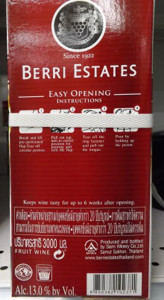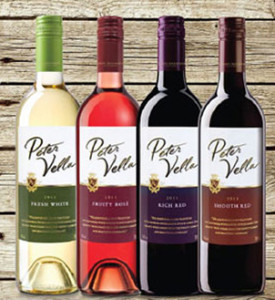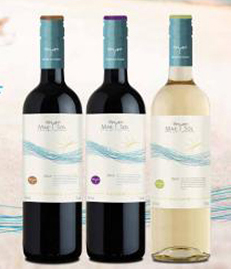[Article by David Swartzentruber]
Within the last years, a new type of wine has appeared on Thai shelves. The labels identifying the wines carry snap phrases such as: “Rich & Red” or “Crisp and Fruity”.
However, what these wines are composed of is usually placed on back labels in extremely small print stating “Fruit Wine”.
These wines are produced using up to 20% of juice or wine that is not from grapes. The fruit in this wine could come from pears, apples, pineapples. There is apparently a loophole in the tax code that allows these wines to be taxed at a lower rate than traditional wines made from wine grapes.
The blending of these wines is carried on in various places such as the country where the wines are produced such as South Africa, Spain or Italy, stopover countries such as Vietnam or at wineries in Thailand such as Siam Winery.
The main attraction for consumers is a lower price. The wines are usually priced in the 249-299 THB per bottle price range.
The fact that these wines are allowed to be sold on shelves adjacent to traditional grape wines raises a number of issues such as consumer deception, labeling standards and health and safety standards.
For many years the Thai government has been trying to erase its image as a marketplace for fraudulent goods. Now this crusade has taken a setback in the Thai wine market and this has happened with the approval of the Thai Excise Department. The fruit wines also prey on the Thai public, most of whom know little about wine.
What concerns me the most is the font size and placement of the words, “Fruit Wine”. The phrase should be placed on the front label of the wine in the same size as the snap phrases listed above. Underneath the “Fruit Wine” in parenthesis in smaller type there should be a statement such as: (This wine contains 20% pear juice). In only this way can consumers know what they are ingesting.
Additionally, where are these wines blended? I am not concerned when these fruit wines are blended in a licensed and bonded winery open to regular health and safety inspections but what about fruit wines concocted in Vietnam, a country that is not a major wine producer. As one colleague stated, “This could be a disaster waiting to happen”.
The cause behind all of this alchemistry is the over-taxation of grape wines by the Thai Excise Department. It seems that the Thai general public has been fed over the years a large amount of anti-wine propaganda: wine is expensive and wine is a luxury. The fact is that the only reason wine is expensive is the high tax imposed on wine by the Thai government.
And the anti-wine propaganda fails to mention the many health benefits of moderate wine consumption.
There will be no changes in excise tax policies in Thailand unless all sectors of the wine industry: Thai wineries, importers, distributors, retailers and consumers unite to deal with the excise gurus. Until now, this has not happened.
The Wines
 The blending of wines in Thailand started a few years ago when two wineries, the Knight Black Horse Winery in Pathum Thani and Siam Winery, owned by the Yoovidhya family of Red Bull fame, began the process.
The blending of wines in Thailand started a few years ago when two wineries, the Knight Black Horse Winery in Pathum Thani and Siam Winery, owned by the Yoovidhya family of Red Bull fame, began the process.
Knight Black Horse began marketing its wines in local shopping malls with labels reading: “Cabernet Sauvignon” and written below that the name of a local indigenous grape, “Black Opal.”
Later there apparently was an intervention and the winery was compelled to place a strip label on the back of the bottle reading: “WINE FROM FRANCE.” Perhaps a better placement should have been on the front of the bottle to aid consumers.
 A few years back, Siam Winery began selling Montclair “Celebration White and Red” with a label declaring, “From the Breede River Valley in South Africa.” As in the other blended wines being sold, consumers have to turn to the back label to read that the wine in the bottle is “Fruit Wine” and “Produced and bottled by Siam Winery.”
A few years back, Siam Winery began selling Montclair “Celebration White and Red” with a label declaring, “From the Breede River Valley in South Africa.” As in the other blended wines being sold, consumers have to turn to the back label to read that the wine in the bottle is “Fruit Wine” and “Produced and bottled by Siam Winery.”
There are now seven other fruit wine labels on the Thai market: Belleville, Berri Estates and Cask 88 (Aussie Red and White), from Australia; Corte Antica, from Italy; Finca De Malpica from Spain; Mar Sol, from Chile; and Peter Vella, a low-tier wine produced by the Gallo Winery, California. With the exception of Belleville and Corte Antica, all of these fruit wines appear to come out of Siam Winery.
 The Corte Antica fruit wine is of special interest because it was bottled in Italy and on the back label near the “Fruit wine” designation the ingredients of the wine are listed: “wine, sugar, fruit juice, aroma, preservative E202.” At least consumers have some idea of what they are drinking.
The Corte Antica fruit wine is of special interest because it was bottled in Italy and on the back label near the “Fruit wine” designation the ingredients of the wine are listed: “wine, sugar, fruit juice, aroma, preservative E202.” At least consumers have some idea of what they are drinking.
Consumers deceived?
When I was researching this article standing in front of a wine display in a Tesco Lotus, four young Thai women began looking at the wines, especially the blended fruit wines because of their lower price. They all spoke very good English. When I explained to them what the orange tax stamp signified, they responded that they did not know this. Most Thais know little about wine, because they have not been able to afford it and will be easily deceived by wines placed on store shelves next to traditional grape wines.
Also, stating in small type on the back label “Fruit wine” is inadequate, it should be stated on the front label and the type of fruit or non-grape wine used should be clearly identified.
Thailand is not a wine-drinking country except for the upper classes. Will these fruit wines be a stepping stone, because of their low price, to attract new Thai customers to wine? Market response to these fruit wines will determine that.
Chaos and solutions
As one might expect the domestic and imported wine industry continues to be hit every year by strange tax policies thought up by the Thai Excise Department that do not come close to international standards. The excise tax increase on wine in 2013 hit the wine sector quite hard.
Now, although it has not been applied, the Thai Excise Department plans to tax the “retail price”. In their statement the department said this would be “internationally acceptable.” Industry executives say this amounts to a “double sales tax.”
I have news for the excise department, taxing the retail price is not internationally acceptable for alcoholic beverages. The international standard is taxing the alcohol in each alcohol product by the amount of alcohol in that product. This is known as Alcohol By Volume, “ABV.”
The high taxes on wine have virtually killed the market, especially in the hospitality sector. This is not the way to attract “high-quality tourists” as the Tourism Authority of Thailand hopes to achieve.The result is the production of these cheap fruit wines, which may also raise concerns about the health and safety of these products. The Public Health Ministry should clearly investigate the manner in which these fruit wines are blended.
Meanwhile, the illegal smuggled wine business is booming, industry executives tell this writer. Yet, there are never any busts or arrests. The last one I saw published in local news media was around 2005 describing confiscation of wines in the east near Cambodia. The answer to this stares one right in the face. Lower the excise tax on wine to an acceptable level, wine will sell more, the government will reap more excise tax income and the smuggled wine business will vanish. Smuggled wine has drained billions of baht in lost revenue from the Thai government over the years, expert observers maintain.
In this time of reform, a reform of the Thai Excise Department and its bizarre tax strategies on wine is clearly overdue and some part of the government, such as the Department of Special Investigation, needs to stop the wine smuggling racket.



 0
0